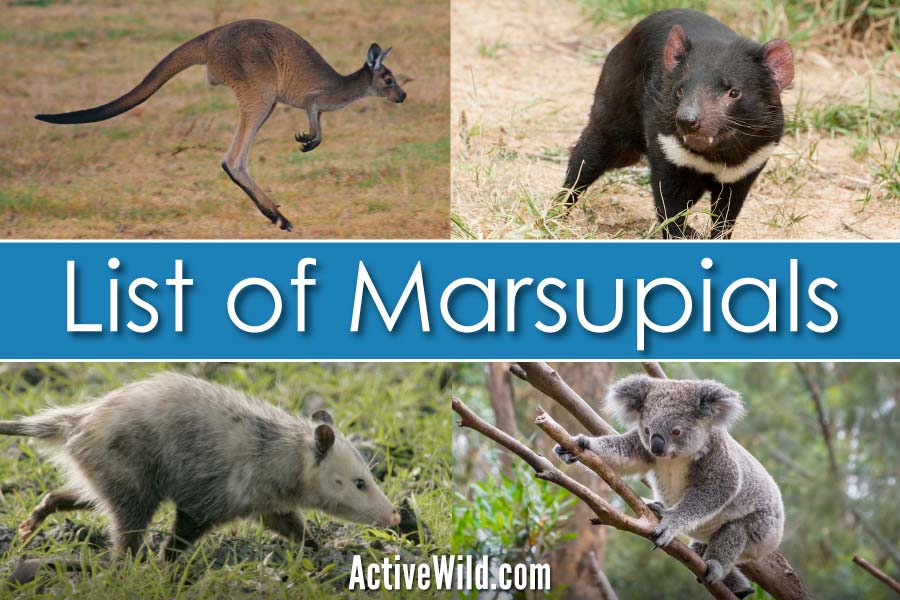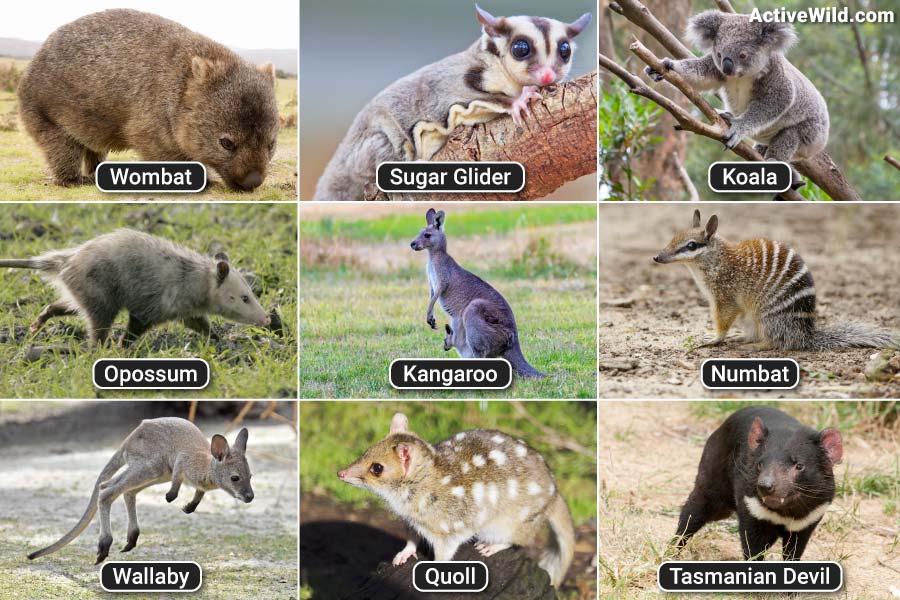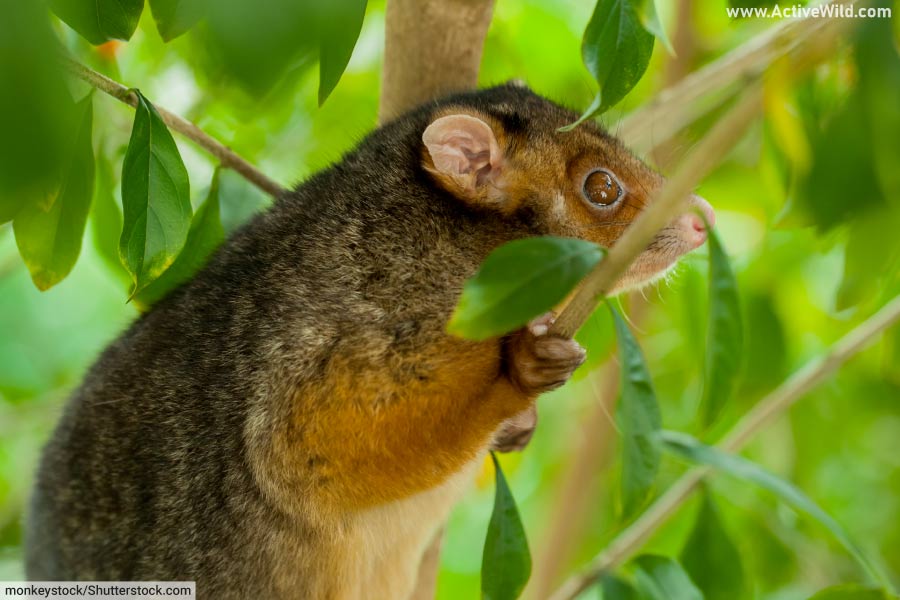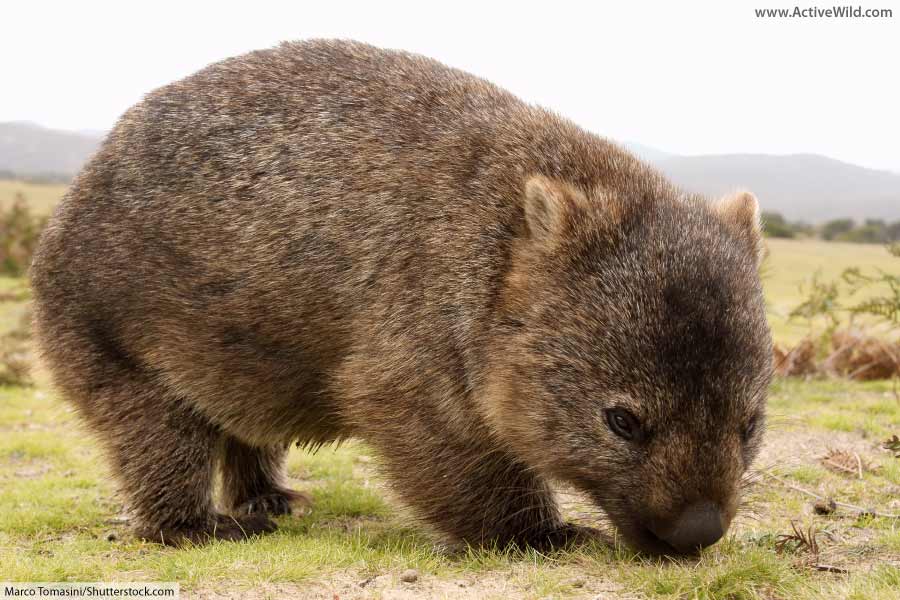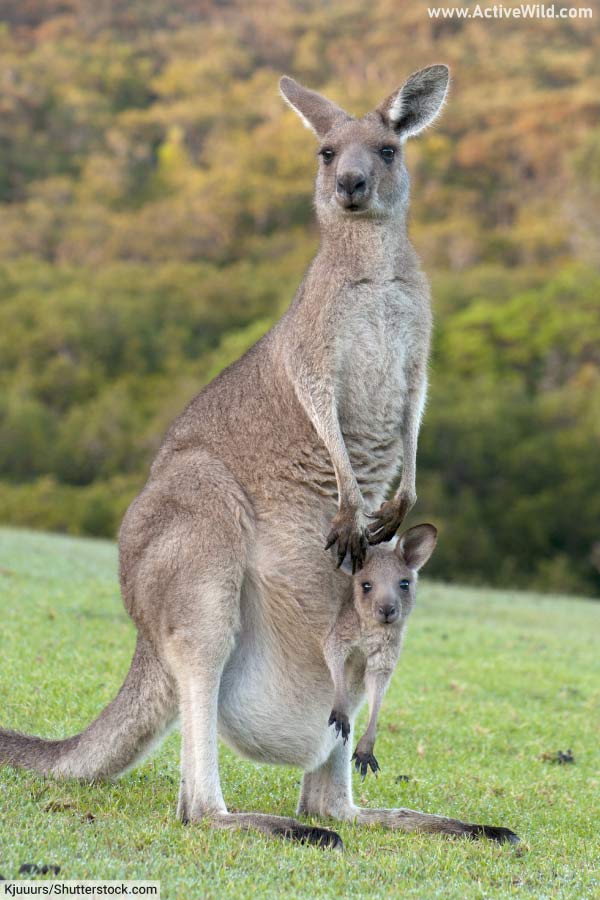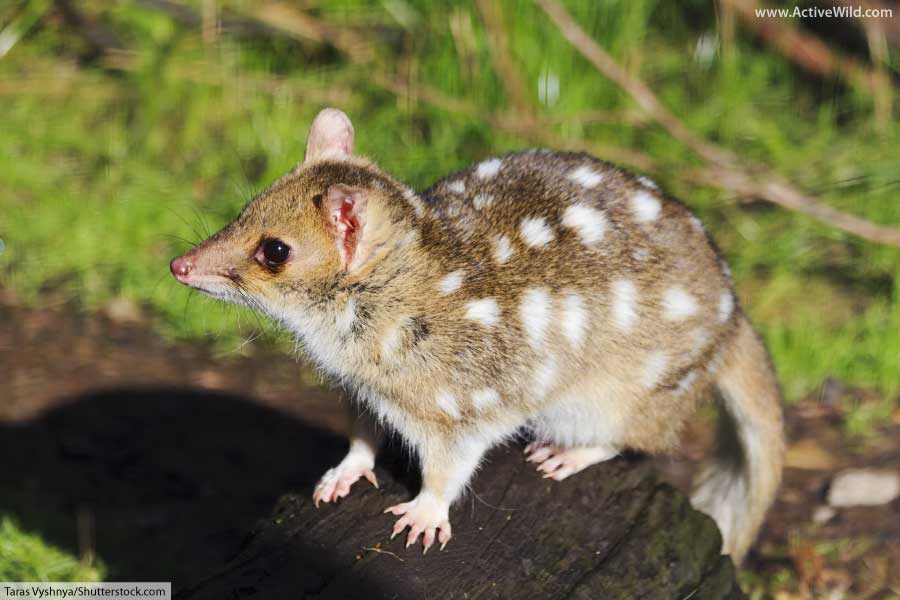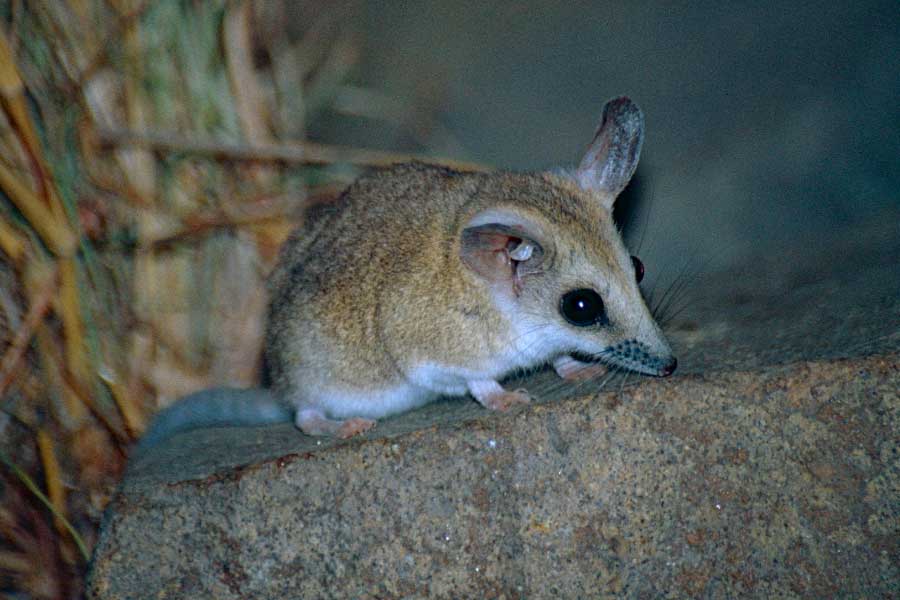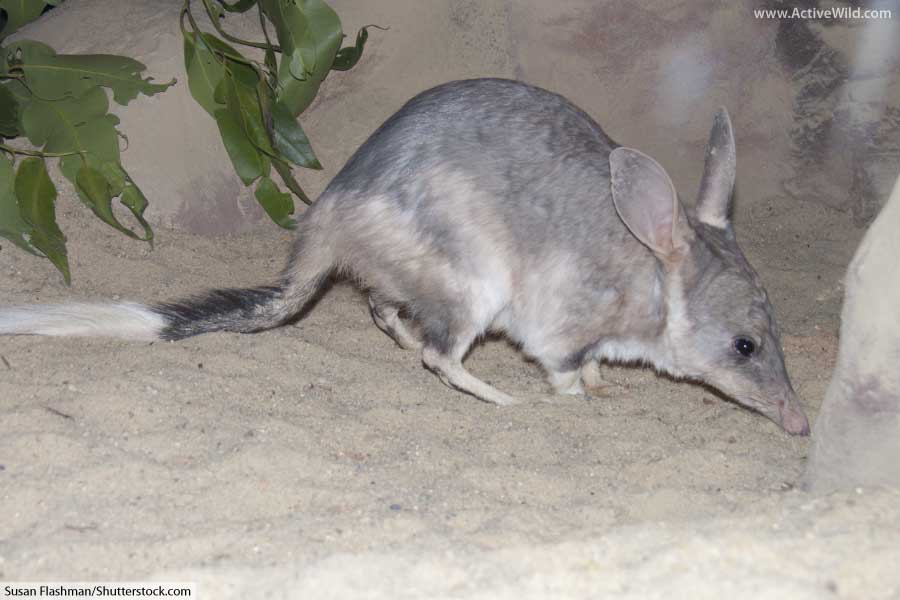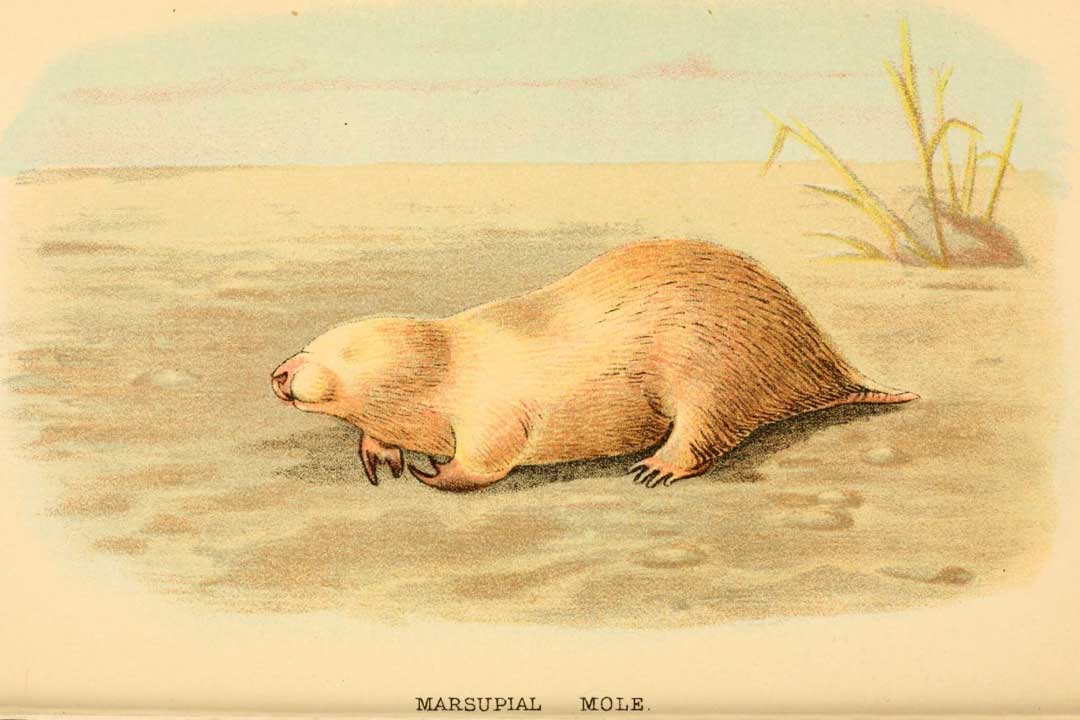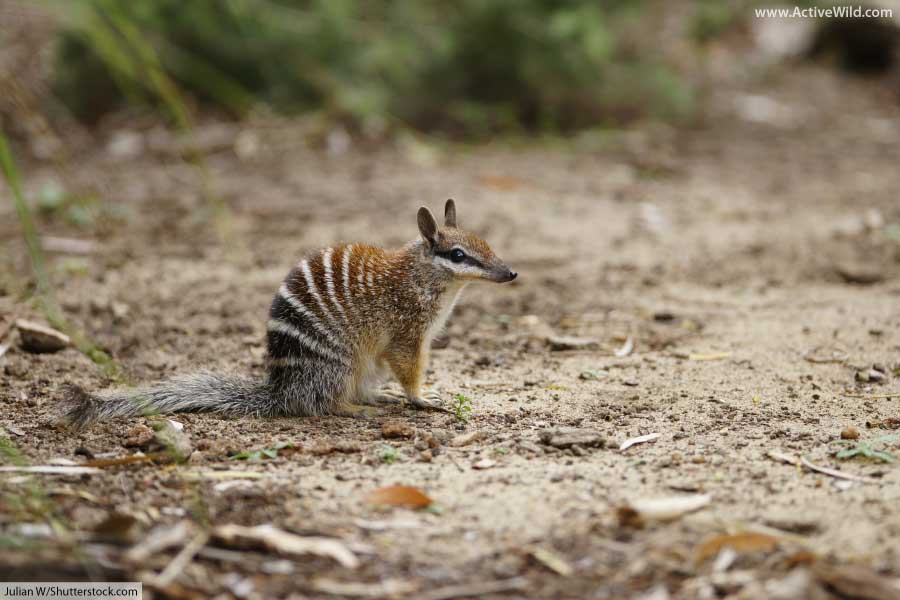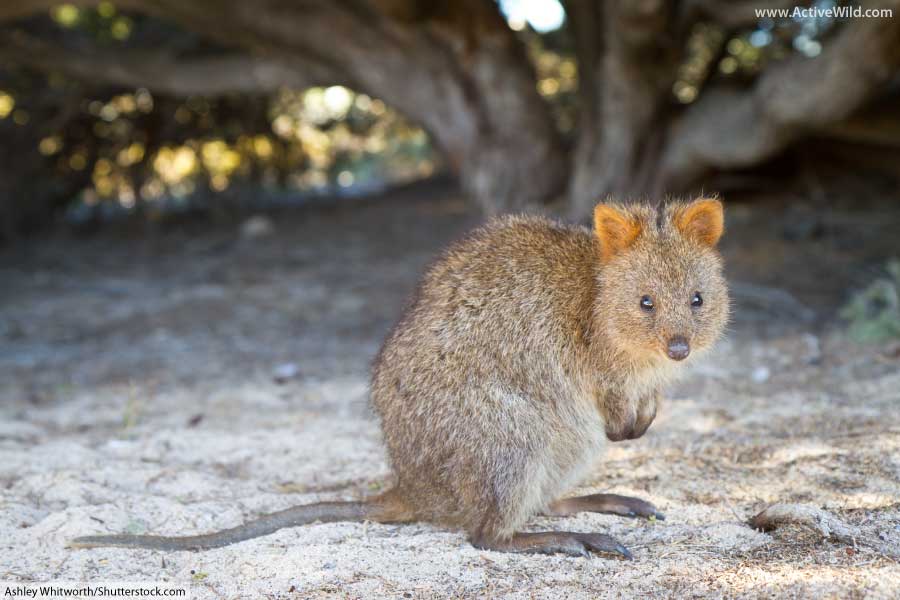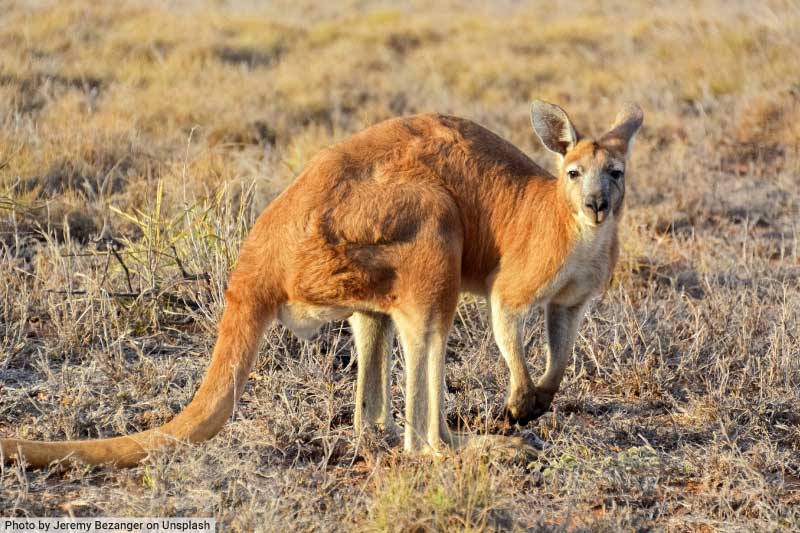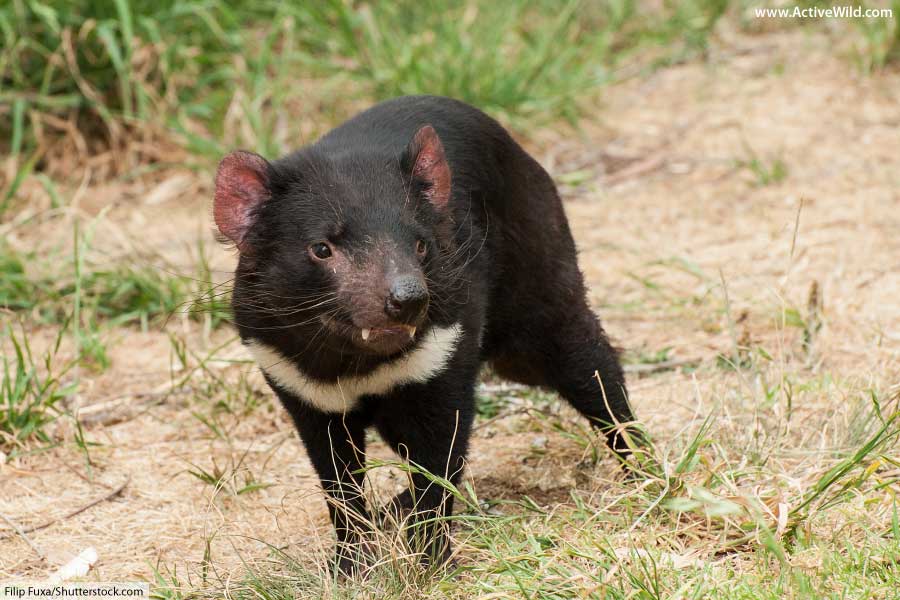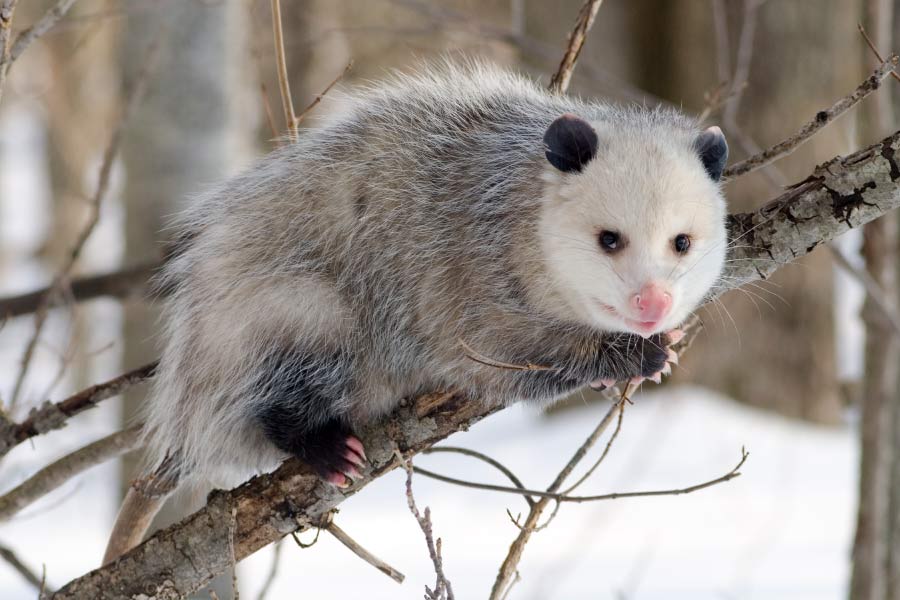A list of marsupials with pictures and facts. Included are well-known and interesting examples of the main types of marsupials.
Examples Of Marsupials
Examples of marsupials include kangaroos, wallabies, possums, bandicoots, quolls, wombats, tree kangaroos, Antechinus, dunnarts, bettongs, the koala, quokka, sugar glider, Tasmanian devil and Virginia opossum.
In the list of marsupials below you’ll find pictures and facts on these and more marsupial species.
Page Index
- Introduction To Marsupials
- Types Of Marsupials
- List Of Marsupials
- Brown Antechinus
- Common Brushtail Possum
- Common Ringtail Possum
- Common Wombat
- Eastern Barred Bandicoot
- Eastern Bettong
- Eastern Caenolestid
- Eastern Grey Kangaroo
- Eastern Quoll
- Fat-Tailed Dunnart
- (Greater) Bilby
- Greater Gliders
- Koala
- Kowari
- Lumholtz's Tree-Kangaroo
- Marsupial Moles
- Numbat
- Quokka
- Red Kangaroo
- Red-Necked Wallaby / Bennett's Wallaby
- Sugar Glider
- Tasmanian Devil
- Virginia Opossum
- List Of Marsupials: Conclusion
Introduction To Marsupials
(Click here to go directly to the List of Marsupials)
Marsupials comprise one of three main mammal groups (the others being the egg-laying monotremes, and the placental mammals, including humans).
Marsupials are also known as “pouched mammals”. Unlike placental mammals, marsupials give birth to relatively undeveloped young, which in many marsupial species are known as “joeys”.
After being born, a young marsupial undergoes further development in a special pouch in its mother’s body. Here it is protected from predators and the environment, and has access to its mother’s milk.
Most of the world’s marsupial species (around 70%) are found on the continent of Australia and nearby islands. The very first marsupials, however, evolved in the Americas.
Outside of Australia, most of today’s marsupials are found in South America (only one species, the Virginia Opossum, is found further north than Mexico).
In total, there are around 330 marsupial species. They make up the infraclass Marsupiala. Like any other large animal groups, Marsupiala is split into subgroups such as orders and families.
Types Of Marsupials
Some of the better-known types of marsupials include: antechinus, bandicoots, bettongs, dunnarts, gliders, kangaroos, opossums, possums, quolls and wombats.
An example species from each major group has been included in the list of marsupials below.
List Of Marsupials
Brown Antechinus
- Scientific name: Antechinus stuartii
- Conservation status: Least Concern
- Where found: Australia
The brown antechinus is one of 15 currently recognized antechinus species. This house mouse-sized marsupial has a pointed snout, rounded ears, and a tail the same length as its body (between 9 and 13 cm / 3.54 and 5.12 in.)
The brown antechinus is nocturnal and arboreal (tree-dwelling). Females live in communal nests in trees. The species is found in forests in eastern Australia.
As with all antechinus, the males die shortly after their first mating season. (Females usually produce two or three litters in their lifetimes.)
Female brown antechinus lack a true pouch. Instead, a flap of skin covers the teats and protects the young as they develop.
Common Brushtail Possum
- Scientific name: Trichosurus vulpecula
- Conservation status: Least Concern
- Where found: Australia (introduced to New Zealand)
The common brushtail possum is a cat-sized, nocturnal, arboreal (tree-dwelling) possum found across much of mainland Australia, as well as on Tasmania and several smaller islands. The species inhabits forests and woodlands and is also found in towns and cities, where it is often seen foraging in gardens and parks.
The common brushtail possum is an introduced species in New Zealand, where it is now considered a pest due to the damage can cause to crops and the negative effect its presence has had on native wildlife.
Common Ringtail Possum
- Scientific name: Pseudocheirus peregrinus
- Conservation status: Least Concern
- Where found: Australia
The common ringtail possum is found in north eastern, eastern and south eastern Australia and is present on Tasmania. It is arboreal (tree-dwelling), and usually found in moist forests and scrublands. The species is also found in urban areas.
The common ringtail possum produces special edible droppings during the day. Eating these droppings allows the species to get the maximum benefit from the food it eats.
The distinctive, white-tipped tail of the common ringtail possum is prehensile (able to grip), and is used as a fifth hand when the animal is climbing.
Common Wombat
- Scientific name: Vombatus ursinus
- Conservation status: Least Concern
- Where found: Australia
The common wombat is one of three living species of wombat (the other two are the southern hairy-nosed wombat and the critically endangered northern hairy-nosed wombat.) The common wombat can be identified by its relatively large, hairless nose.
The species is stockily built, with a body length of around 1 m / 3.28 ft. Weighing around the same as a Labrador, the common wombat is one of the world’s largest burrowing animals. Although a largely solitary species, multiple common wombats will sometimes share the same large tunnel systems.
The species is found in temperate, moist forests and shrublands in south eastern Australia.
- You can find out more about wombats on this page: Wombat Facts
Eastern Barred Bandicoot
- Scientific name: Perameles gunnii
- Conservation status: Vulnerable
- Where found: Australia
The eastern barred bandicoot is a rabbit-sized marsupial with yellow-brown fur and 3 or 4 darker brown bars on its rump (the “bars” in the species’ name).
The species is found on Tasmania and in two locations in Victoria. The mainland populations are reintroductions aimed at preventing the extinction of the species on the mainland.
The introduction of non-native species (in particular the red fox) caused the initial decline of the eastern barred bandicoot on the mainland.
Eastern Bettong
- Scientific name: Bettongia gaimardi
- Conservation status: Near Threatened
- Where found: Australia
The eastern bettong is native to Tasmania and southeastern mainland Australia. The mainland population became extinct as a result of the introduction of non-native species (in particular the red fox).
The species is one of four living bettongs (five including the rufous bettong, also known as the rat kangaroo, which belongs to a different genus). Bettongs belong to the same family, Potoroidae, as the potoroos and the rufous bettong / rat-kangaroo.
The eastern bettong is a rabbit-sized, nocturnal marsupial that moves by hopping.
Eastern Caenolestid
- Scientific name: Caenolestes sangay
- Conservation status: Vulnerable
- Where found: South America
The eastern caenolestid is one of seven species of shrew opossum. These small, shrew-like marsupials make up the family Caenolestidae. All are found on and around the Andes in South America. Shrew opossums are thought to have branched off from other marsupials early on in the evolution of marsupials.
The scientific name of the eastern caenolestid, Caenolestes sangay, refers to Sangay, an active volcano in Ecuador. The eastern caenolestid was first discovered in the Sangay National Park, a park that contains Sangay and another active volcano, Tungurahua.
Eastern Grey Kangaroo
- Scientific name: Macropus giganteus
- Conservation status: Least Concern
- Where found: Australia
The eastern grey kangaroo is the second-largest living marsupial; only the red kangaroo is larger. Males are larger than females and often reach weights of 66 kg / 146 lb.; some individuals are significantly larger. The species has a soft, pale gray coat.
A social animal, the eastern grey kangaroo usually lives in groups of three or more individuals. Larger groups can form when food is plentiful. (A group of kangaroos is known as a “mob”.)
This common Australian marsupial is found in habitats ranging from grasslands to forests throughout much of eastern Australia.
Eastern Quoll
- Scientific name: Dasyurus viverrinus
- Conservation status: Endangered
- Where found: Australia
Once found in southeastern mainland Australia, the eastern quoll is now present only on the island state of Tasmania. The species is one of six species of quoll, and one of four found in Australia (the other two are found on New Guinea).
The eastern quoll, like other quolls, is a carnivorous marsupial. A nocturnal hunter, it preys on a variety of small animals, including mammals, reptiles, birds and insects. The species is known to approach feeding Tasmanian devils to take scraps of food.
- You can find out more about quolls on this page: Quoll Facts
Fat-Tailed Dunnart
- Scientific name: Sminthopsis crassicaudata
- Conservation status: Least Concern
- Where found: Australia
The fat-tailed dunnart is a small marsupial found in dry grasslands, deserts and savannas across much of Australia. It is one of around 20 dunnart species, which together make up the genus Sminthopsis.
Dunnarts are mouse-sized marsupials with a diet that consists mainly of insects. They belong to the family Dasyuridae, which includes several other marsupial groups, including the dasyures, mulgaras, marsupial shrews, antechinus and quolls, as well as the Kowari and Tasmanian devil.
The fat-tailed dunnart is one of the smallest carnivorous marsupials. It hunts at night, feeding on insects and small reptiles and mammals. Each night it consumes its own body weight in prey.
During the day it enters a state of hibernation-like torpor to conserve energy. It can also use energy stored in the fat of its tail.
(Greater) Bilby
- Scientific name: Macrotis lagotis
- Conservation status: Vulnerable
- Where found: Australia
With the extinction of the lesser bilby in the 1950’s, the greater bilby became the only living bilby; therefore the “greater” part of its name is often dropped.
The greater bilby has a maximum body length of around 55 cm / 21.65 in. Its fur is pale, blueish-gray in color. The species has large ears and a pointed nose (the genus name Macrotis means “big-eared”.) It is also known as the rabbit-eared bandicoot.
The greater bilby is a nocturnal burrowing animal found in dry grasslands and savannas. An omnivore, its diet consists of insects, insect larvae, seeds, bulbs and other plant matter.
The bilby’s closest relations are the bandicoots; it and the bandicoots belong to the marsupial order Peramelemorphia.
- You can find out more about the greater bilby on this page: Bilby Facts
Greater Glider
- Scientific name: Genus Petauroides
- Where found: Australia
Until recently, the three species of greater glider were considered to be subspecies of a single species, Petauroides Volans, which had a conservation status of Vulnerable.
The three newly-recognized species are: the central greater glider (Petauroides armillatus), northern greater glider (Petauroides minor) and southern greater glider (Petauroides volans).
The greater gliders have a skin membrane between their elbows and knees which, when extended, allows them to glide from tree to tree.
The southern greater glider, which is the size of a domestic cat, is among the world’s largest gliding animals.
All three greater glider species are found in forests eastern Australia. They are arboreal (tree-dwelling), nocturnal, and mainly folivorous (leaf-eating).
Koala
- Scientific name: Phascolarctos cinereus
- Conservation status: Vulnerable
- Where found: Australia
Despite being one of the most famous marsupials, the koala’s conservation status is Vulnerable and its population is decreasing. The distinctive grey-haired, furry-eared, black-nosed marsupial is found in forests and woodlands in eastern Australia.
The koala is a solitary, tree-dwelling animal. Its diet consists mainly of leaves of trees of genus Eucalyptus. Adaptations to the koala’s teeth and stomach allow it to live on the leaves, which are toxic and low in both energy and nutritional value.
- You can find out more about the koala on this page: Koala Facts
Kowari
- Scientific name: Dasyuroides byrnei
- Conservation status: Vulnerable
- Where found: Australia
The kowari is a small marsupial midway between a mouse and rat in size. It is grey with a large tuft of bushy black hair at the end of its tail (the species’ alternative name is brush-tailed marsupial rat).
The kowari is found in deserts and shrublands in the Channel Country in the Australian outback. It lives in burrows, and feeds on insects and spiders.
Livestock farming in its traditional habitat has caused a decline in the species’ population and it is now rated Vulnerable.
Lumholtz's Tree-Kangaroo
- Scientific name: Dendrolagus lumholtzi
- Conservation status: Near Threatened
- Where found: Australia
Tree kangaroos are a group of kangaroos with adaptations for an arboreal (tree-dwelling) lifestyle, including long tails, large feet and long arms. There are 13 species of tree kangaroo; together they make up the genus Dendrolagus.
Lumholtz's tree-kangaroo is one of just two tree kangaroos found in Australia (the other being Bennett's tree-kangaroo, Dendrolagus bennettianus). The other tree kangaroos are found on New Guinea and neighboring islands.
Lumholtz's tree-kangaroo is the smallest tree kangaroo, weighing 7 kg / 15.4 lb. and with a body and tail length of 1.24 m / 4.1 ft. It is found in the rainforests of Queensland, Australia. The species is solitary outside of the mating season, and usually active at night.
Marsupial Moles
- Scientific name: southern marsupial mole: Notoryctes typhlops
- Scientific name: northern marsupial mole: Notoryctes caurinus
- Conservation status: Least Concern
- Where found: Australia
The two species of marsupial mole make up the family Notoryctidae. These marsupials spend most of their lives underground in Australia’s sandy deserts and only rarely come to the surface.
Marsupial moles have numerous adaptations for living underground. They are blind (their eyes are non-functional and found under the skin) and lack external ears. Their forelimbs are equipped with special claws for burrowing through the sand. Their pouches face backwards to avoid sand entering as they tunnel.
Numbat
- Scientific name: Myrmecobius fasciatus
- Conservation status: Endangered
- Where found: Australia
The numbat is an endangered marsupial found in forests in Western Australia. It is squirrel-sized, with reddish-brown fur and several pale stripes across its back.
Unusually for a marsupial, the numbat is diurnal (active during the day). Its diet consists mainly of termites, of which it eats around 20,000 per day. Its tongue is long and sticky for capturing its insect prey.
- You can find out more about the numbat on this page: Numbat Facts
Quokka
- Scientific name: Setonix brachyurus
- Conservation status: Vulnerable
- Where found: Australia
The quokka is a cat-sized member of the kangaroo family Macropodidae. It is found on several islands off the West Australia coast and in a number of locations in southwest West Australia.
Like many Australian marsupials, the quokka’s mainland population was negatively affected by the arrival of non-native predators such as the red fox.
Tourists visit Rottnest Island, which lies around 12 miles west of Perth, to view the island’s resident quokkas. The island’s name means “rat’s nest” in Dutch. It was named after Dutch sailors mistook the island’s quokkas for rats.
Like all macropods, the quokka is herbivorous. It moves by hopping, but will walk on all four limbs when browsing.
- You can find out more about the quokka on this page: Quokka Facts
Red Kangaroo
- Scientific name: Osphranter rufus
- Conservation status: Least Concern
- Where found: Australia
The red kangaroo is not only the largest kangaroo, it’s also the largest marsupial and Australia’s largest mammal. A large male red kangaroo has a body length of 1.6 m / 5.25 ft, but some individuals exceed 2 m / 6.56 ft. in body length. Males are red-brown in color; females, which are significantly smaller, are gray-blue.
The red kangaroo is found in arid (dry) regions across much of Australia. It is found in a variety of habitats, including grasslands, savannas, deserts and woodlands. It is herbivorous, mainly eating grasses and flowers.
- You can find out more about the red kangaroo on this page: Red Kangaroo Facts
Red-Necked Wallaby / Bennett's Wallaby
- Scientific name: Macropus rufogriseus
- Conservation status: Least Concern
- Where found: Australia
Kangaroos, wallabies, wallaroos (which are in-between kangaroos and wallabies in size) and related species all belong to the same family, Macropodidae. The four largest members of the family are kangaroos; the name “wallaby” is given to the smaller members of the family.
The red-necked wallaby is also known as Bennett’s wallaby. It is found in forests, shrublands and grasslands in eastern mainland Australia and on Tasmania. It has a body length of around 90 cm / 2.95 ft. Its fur is soft and gray in color, with a reddish tinge, particularly across the back of the neck.
Sugar Glider
- Scientific name: Petaurus breviceps
- Conservation status: Least Concern
- Where found: Australia, New Guinea
The sugar glider is a small possum that has evolved the ability to glide via membranes between the hands and feet. Gliding from tree to tree (rather than climbing) uses less energy and is also a means of evading predators.
The sugar glider can glide over distances of up to 50 m / 164 ft.
The sugar glider has a body and tail length of around 27 cm / 10.63 in. It is nocturnal and omnivorous. Its diet consists of the sap / gum from trees, and insects.
- You can find out more about the sugar glider on this page: Sugar Glider Facts
Tasmanian Devil
- Scientific name: Sarcophilus harrisii
- Conservation status: Endangered
- Where found: Australia
The Tasmanian devil is the world’s largest carnivorous marsupial. The size of a small dog (e.g., a Jack Russell), the Tasmanian devil is black in color, often with white patches. It is a powerfully-built animal, with a proportionally stronger bite force than any other carnivorous mammal.
Although primarily a scavenger, the Tasmanian devil is able to hunt its own prey. Its name comes from the devilish shrieks produced by squabbling Tasmanian devils.
The Tasmanian devil became extinct on mainland Australian around 3,000 years ago, and was only found on Tasmania. It has recently (2020) been reintroduced to the mainland in an attempt to protect the species from the spread of a disease that has caused the Tasmanian devil to become endangered.
- You can find out more about the Tasmanian devil on this page: Tasmanian Devil Facts
Virginia Opossum
- Scientific name: Didelphis virginiana
- Conservation status: Least Concern
- Where found: Central and North America
The Virginia opossum is a marsupial found in Central and North America. With a range that extends from Costa Rica to Canada, it is found further north than any other marsupial. It is the only marsupial found in the United States and Canada.
A solitary, nocturnal animal, the Virginia opossum is an omnivore whose diet includes insects, small vertebrates, eggs, and carrion. The species is found in a variety of habitats, including forests, shrublands and urban environments; the Virginia opossum will raid trash cans and is often found in backyards and parks.
The term ‘playing possum’ comes from the Virginia opossum’s survival strategy of pretending to be dead when threatened.
- You can find out more about the Virginia opossum on this page: Virginia Opossum Facts
List Of Marsupials: Conclusion
You can find out more about marsupials and other animals on the following pages:

